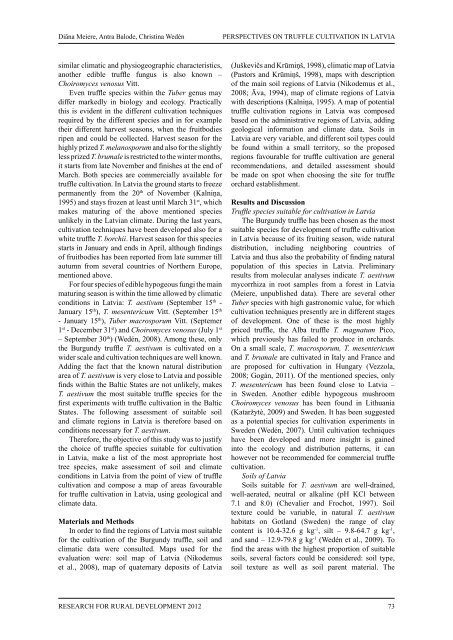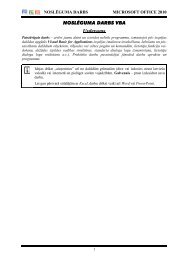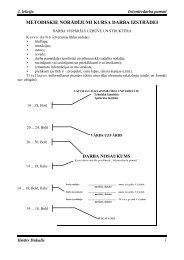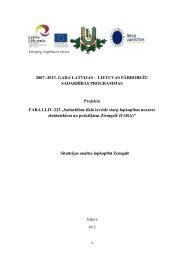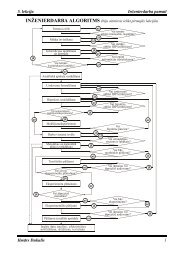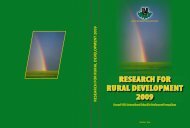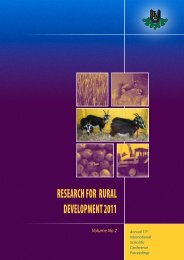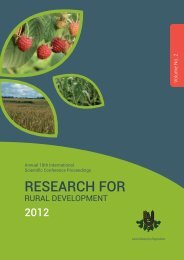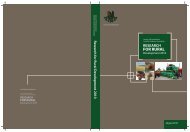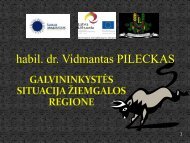LATVIA UNIVERSITY OF AGRICULTURE - Latvijas ...
LATVIA UNIVERSITY OF AGRICULTURE - Latvijas ...
LATVIA UNIVERSITY OF AGRICULTURE - Latvijas ...
- No tags were found...
You also want an ePaper? Increase the reach of your titles
YUMPU automatically turns print PDFs into web optimized ePapers that Google loves.
Diāna Meiere, Antra Balode, Christina WedénPERSPECTIVES ON TRUFFLE CULTIVATION IN <strong>LATVIA</strong>similar climatic and physiogeographic characteristics,another edible truffle fungus is also known –Choiromyces venosus Vitt.Even truffle species within the Tuber genus maydiffer markedly in biology and ecology. Practicallythis is evident in the different cultivation techniquesrequired by the different species and in for exampletheir different harvest seasons, when the fruitbodiesripen and could be collected. Harvest season for thehighly prized T. melanosporum and also for the slightlyless prized T. brumale is restricted to the winter months,it starts from late November and finishes at the end ofMarch. Both species are commercially available fortruffle cultivation. In Latvia the ground starts to freezepermanently from the 20 th of November (Kalniņa,1995) and stays frozen at least until March 31 st , whichmakes maturing of the above mentioned speciesunlikely in the Latvian climate. During the last years,cultivation techniques have been developed also for awhite truffle T. borchii. Harvest season for this speciesstarts in January and ends in April, although findingsof fruitbodies has been reported from late summer tillautumn from several countries of Northern Europe,mentioned above.For four species of edible hypogeous fungi the mainmaturing season is within the time allowed by climaticconditions in Latvia: T. aestivum (September 15 th -January 15 th ), T. mesentericum Vitt. (September 15 th- January 15 th ), Tuber macrosporum Vitt. (Septemer1 st - December 31 st ) and Choiromyces venosus (July 1 st– September 30 th ) (Wedén, 2008). Among these, onlythe Burgundy truffle T. aestivum is cultivated on awider scale and cultivation techniques are well known.Adding the fact that the known natural distributionarea of T. aestivum is very close to Latvia and possiblefinds within the Baltic States are not unlikely, makesT. aestivum the most suitable truffle species for thefirst experiments with truffle cultivation in the BalticStates. The following assessment of suitable soiland climate regions in Latvia is therefore based onconditions necessary for T. aestivum.Therefore, the objective of this study was to justifythe choice of truffle species suitable for cultivationin Latvia, make a list of the most appropriate hosttree species, make assessment of soil and climateconditions in Latvia from the point of view of trufflecultivation and compose a map of areas favourablefor truffle cultivation in Latvia, using geological andclimate data.Materials and MethodsIn order to find the regions of Latvia most suitablefor the cultivation of the Burgundy truffle, soil andclimatic data were consulted. Maps used for theevaluation were: soil map of Latvia (Nikodemuset al., 2008), map of quaternary deposits of Latvia(Juškevičs and Krūmiņš, 1998), climatic map of Latvia(Pastors and Krūmiņš, 1998), maps with descriptionof the main soil regions of Latvia (Nikodemus et al.,2008; Āva, 1994), map of climate regions of Latviawith descriptions (Kalniņa, 1995). A map of potentialtruffle cultivation regions in Latvia was composedbased on the administrative regions of Latvia, addinggeological information and climate data. Soils inLatvia are very variable, and different soil types couldbe found within a small territory, so the proposedregions favourable for truffle cultivation are generalrecommendations, and detailed assessment shouldbe made on spot when choosing the site for truffleorchard establishment.Results and DiscussionTruffle species suitable for cultivation in LatviaThe Burgundy truffle has been chosen as the mostsuitable species for development of truffle cultivationin Latvia because of its fruiting season, wide naturaldistribution, including neighboring countries ofLatvia and thus also the probability of finding naturalpopulation of this species in Latvia. Preliminaryresults from molecular analyses indicate T. aestivummycorrhiza in root samples from a forest in Latvia(Meiere, unpublished data). There are several otherTuber species with high gastronomic value, for whichcultivation techniques presently are in different stagesof development. One of these is the most highlypriced truffle, the Alba truffle T. magnatum Pico,which previously has failed to produce in orchards.On a small scale, T. macrosporum, T. mesentericumand T. brumale are cultivated in Italy and France andare proposed for cultivation in Hungary (Vezzola,2008; Gogán, 2011). Of the mentioned species, onlyT. mesentericum has been found close to Latvia –in Sweden. Another edible hypogeous mushroomChoiromyces venosus has been found in Lithuania(Kataržytė, 2009) and Sweden. It has been suggestedas a potential species for cultivation experiments inSweden (Wedén, 2007). Until cultivation techniqueshave been developed and more insight is gainedinto the ecology and distribution patterns, it canhowever not be recommended for commercial trufflecultivation.Soils of LatviaSoils suitable for T. aestivum are well-drained,well-aerated, neutral or alkaline (pH KCl between7.1 and 8.0) (Chevalier and Frochot, 1997). Soiltexture could be variable, in natural T. aestivumhabitats on Gotland (Sweden) the range of claycontent is 10.4-32.6 g kg -1 , silt – 9.8-64.7 g kg -1 ,and sand – 12.9-79.8 g kg -1 (Wedén et al., 2009). Tofind the areas with the highest proportion of suitablesoils, several factors could be considered: soil type,soil texture as well as soil parent material. TheResearch for Rural Development 201273


